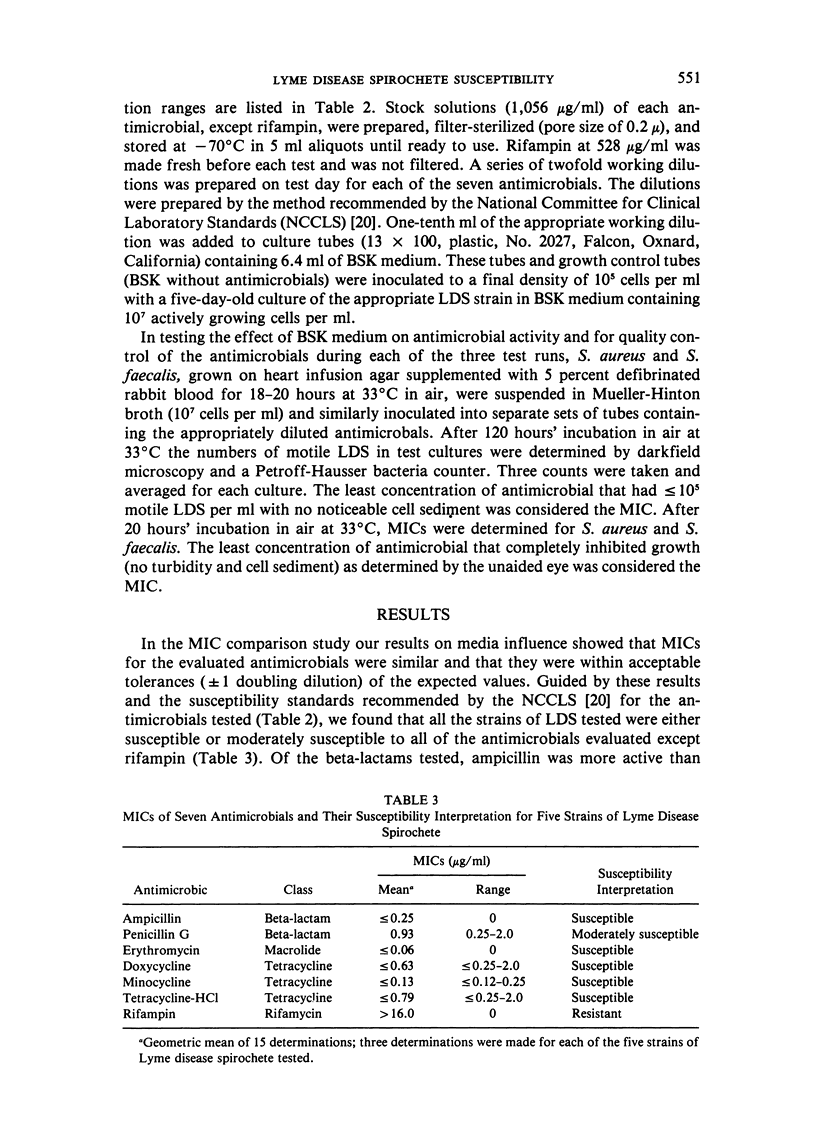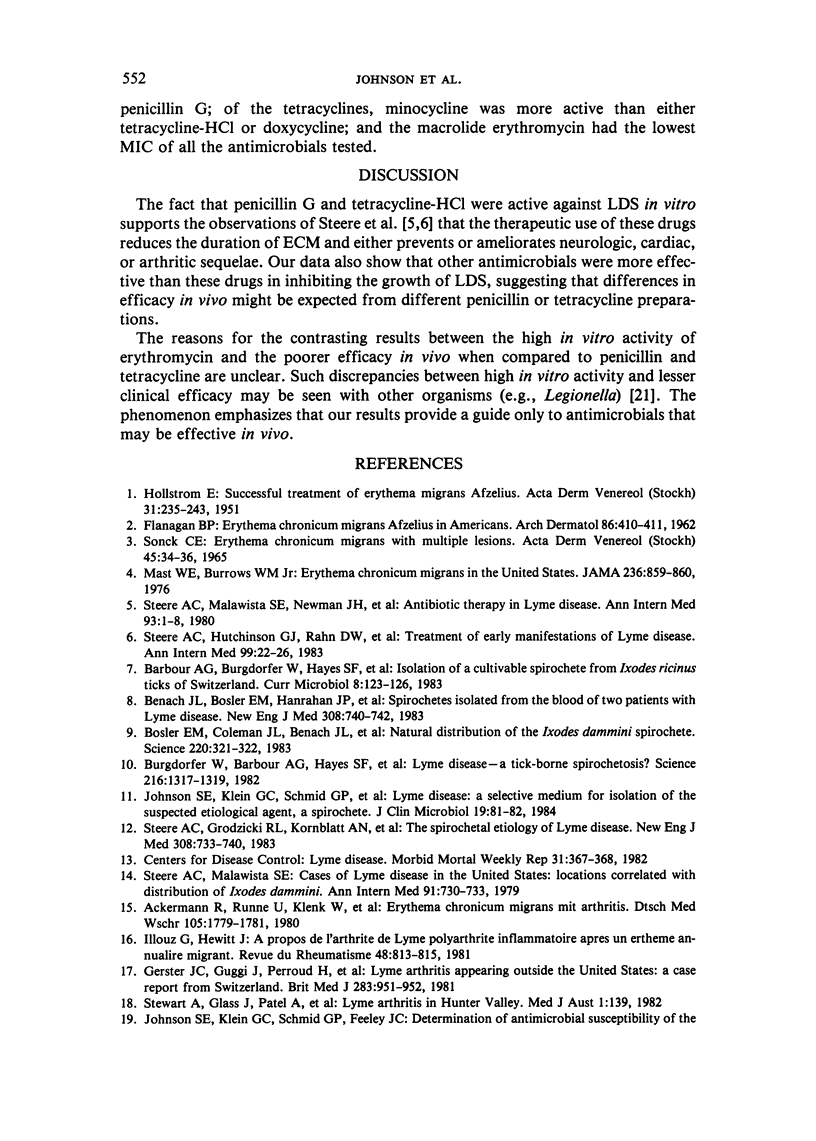Abstract
The antimicrobial susceptibility of five Lyme disease spirochete strains (two human and three tick isolates) was determined. A macrodilution broth technique was used to determine on three separate test occasions the minimal inhibitory concentrations (MICs) of seven antibiotics. The Lyme disease spirochete was most susceptible to erythromycin with a MIC of less than or equal to 0.06 micrograms/ml. The spirochete was also found to be susceptible to minocycline, ampicillin, doxycycline, and tetracycline-HCL with respective mean MICs of less than or equal to 0.13, less than or equal to 0.25, less than or equal to 0.63, and less than or equal to 0.79 micrograms/ml. The spirochete was moderately susceptible to penicillin G with a mean MIC of 0.93 micrograms/ml. All strains were resistant to rifampin at the highest concentration tested (16.0 micrograms/ml).
Full text
PDF




Selected References
These references are in PubMed. This may not be the complete list of references from this article.
- Ackermann R., Runne U., Klenk W., Dienst C. Erythema chronicum migrans mit Arthritis. Dtsch Med Wochenschr. 1980 Dec 19;105(51):1779–1781. doi: 10.1055/s-2008-1070958. [DOI] [PubMed] [Google Scholar]
- Benach J. L., Bosler E. M., Hanrahan J. P., Coleman J. L., Habicht G. S., Bast T. F., Cameron D. J., Ziegler J. L., Barbour A. G., Burgdorfer W. Spirochetes isolated from the blood of two patients with Lyme disease. N Engl J Med. 1983 Mar 31;308(13):740–742. doi: 10.1056/NEJM198303313081302. [DOI] [PubMed] [Google Scholar]
- Bosler E. M., Coleman J. L., Benach J. L., Massey D. A., Hanrahan J. P., Burgdorfer W., Barbour A. G. Natural Distribution of the Ixodes dammini spirochete. Science. 1983 Apr 15;220(4594):321–322. doi: 10.1126/science.6836274. [DOI] [PubMed] [Google Scholar]
- Burgdorfer W., Barbour A. G., Hayes S. F., Benach J. L., Grunwaldt E., Davis J. P. Lyme disease-a tick-borne spirochetosis? Science. 1982 Jun 18;216(4552):1317–1319. doi: 10.1126/science.7043737. [DOI] [PubMed] [Google Scholar]
- Centers for Disease Control (CDC) Lyme disease. MMWR Morb Mortal Wkly Rep. 1982 Jul 16;31(27):367–368. [PubMed] [Google Scholar]
- FLANAGAN B. P. Erythema chronicum migrans Afzelius in Americans. Arch Dermatol. 1962 Oct;86:410–411. doi: 10.1001/archderm.1962.01590100024007. [DOI] [PubMed] [Google Scholar]
- Gerster J. C., Guggi S., Perroud H., Bovet R. Lyme arthritis appearing outside the United States: a case report from Switzerland. Br Med J (Clin Res Ed) 1981 Oct 10;283(6297):951–952. doi: 10.1136/bmj.283.6297.951-a. [DOI] [PMC free article] [PubMed] [Google Scholar]
- HOLLSTROM E. Successful treatment of erythema migrans Afzelius. Acta Derm Venereol. 1951;31(2):235–243. [PubMed] [Google Scholar]
- Illouz G., Hewitt J. A propos de l'arthrite de Lyme. Polyarthrite inflammatoire après un érythème annulaire migrant. Rev Rhum Mal Osteoartic. 1981 Dec;48(12):813–815. [PubMed] [Google Scholar]
- Johnson S. E., Klein G. C., Schmid G. P., Bowen G. S., Feeley J. C., Schulze T. Lyme disease: a selective medium for isolation of the suspected etiological agent, a spirochete. J Clin Microbiol. 1984 Jan;19(1):81–82. doi: 10.1128/jcm.19.1.81-82.1984. [DOI] [PMC free article] [PubMed] [Google Scholar]
- Mast W. E., Burrows W. M., Jr Erythema chronicum migrans in the United States. JAMA. 1976 Aug 16;236(7):859–860. [PubMed] [Google Scholar]
- Pasculle A. W., Dowling J. N., Weyant R. S., Sniffen J. M., Cordes L. G., Gorman G. M., Feeley J. C. Susceptibility of Pittsburgh pneumonia agent (Legionella micdadei) and other newly recognized members of the genus Legionella to nineteen antimicrobial agents. Antimicrob Agents Chemother. 1981 Dec;20(6):793–799. doi: 10.1128/aac.20.6.793. [DOI] [PMC free article] [PubMed] [Google Scholar]
- Sonck C. E. Erythema chronicum migrans with multiple lesions. Acta Derm Venereol. 1965;45(1):34–36. [PubMed] [Google Scholar]
- Steere A. C., Grodzicki R. L., Kornblatt A. N., Craft J. E., Barbour A. G., Burgdorfer W., Schmid G. P., Johnson E., Malawista S. E. The spirochetal etiology of Lyme disease. N Engl J Med. 1983 Mar 31;308(13):733–740. doi: 10.1056/NEJM198303313081301. [DOI] [PubMed] [Google Scholar]
- Steere A. C., Hutchinson G. J., Rahn D. W., Sigal L. H., Craft J. E., DeSanna E. T., Malawista S. E. Treatment of the early manifestations of Lyme disease. Ann Intern Med. 1983 Jul;99(1):22–26. doi: 10.7326/0003-4819-99-1-22. [DOI] [PubMed] [Google Scholar]
- Steere A. C., Malawista S. E. Cases of Lyme disease in the United States: locations correlated with distribution of Ixodes dammini. Ann Intern Med. 1979 Nov;91(5):730–733. doi: 10.7326/0003-4819-91-5-730. [DOI] [PubMed] [Google Scholar]
- Steere A. C., Malawista S. E., Newman J. H., Spieler P. N., Bartenhagen N. H. Antibiotic therapy in Lyme disease. Ann Intern Med. 1980 Jul;93(1):1–8. doi: 10.7326/0003-4819-93-1-1. [DOI] [PubMed] [Google Scholar]
- Stewart A., Glass J., Patel A., Watt G., Cripps A., Clancy R. Lyme arthritis in the Hunter Valley. Med J Aust. 1982 Feb 6;1(3):139–139. doi: 10.5694/j.1326-5377.1982.tb132207.x. [DOI] [PubMed] [Google Scholar]


